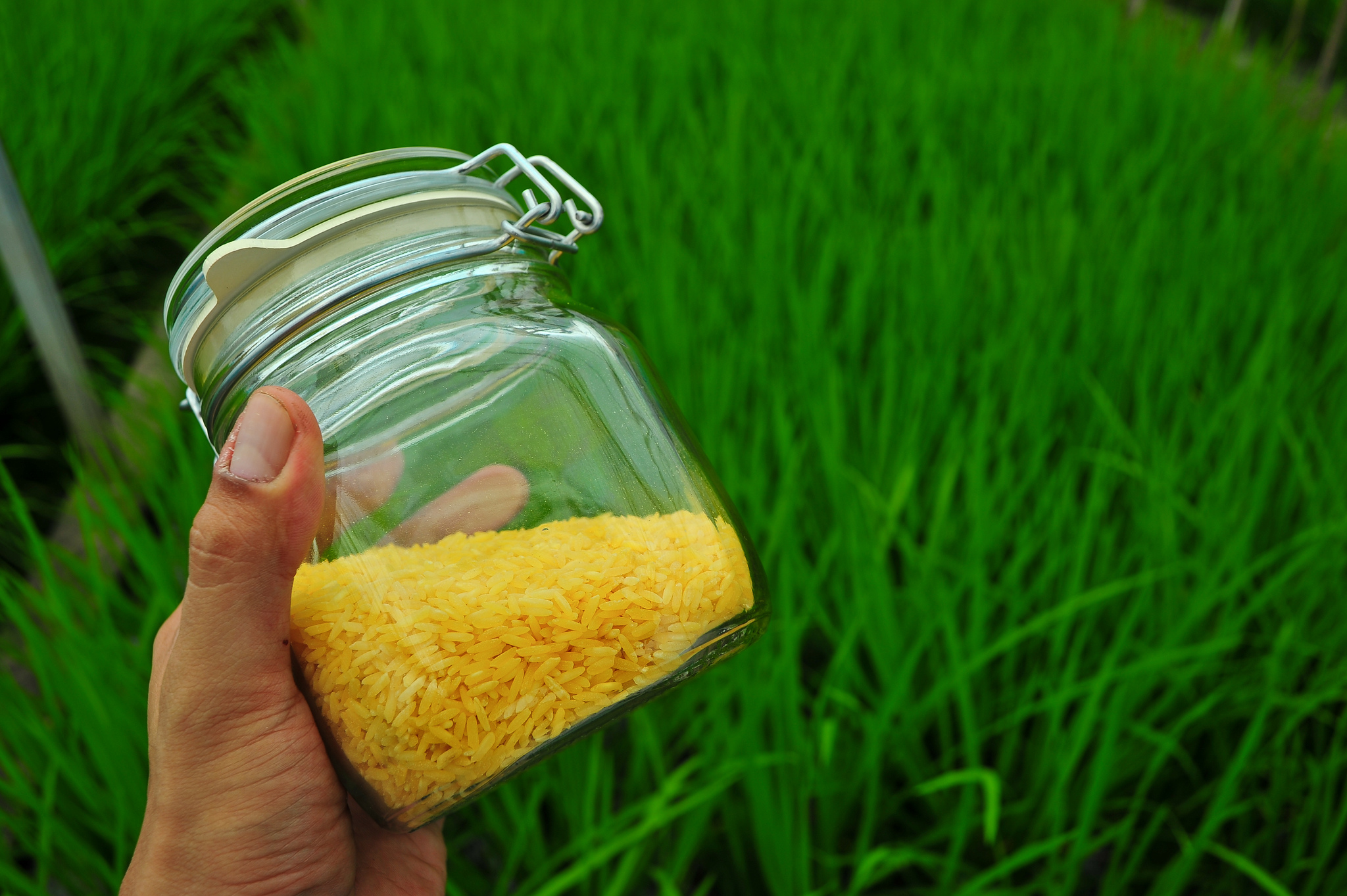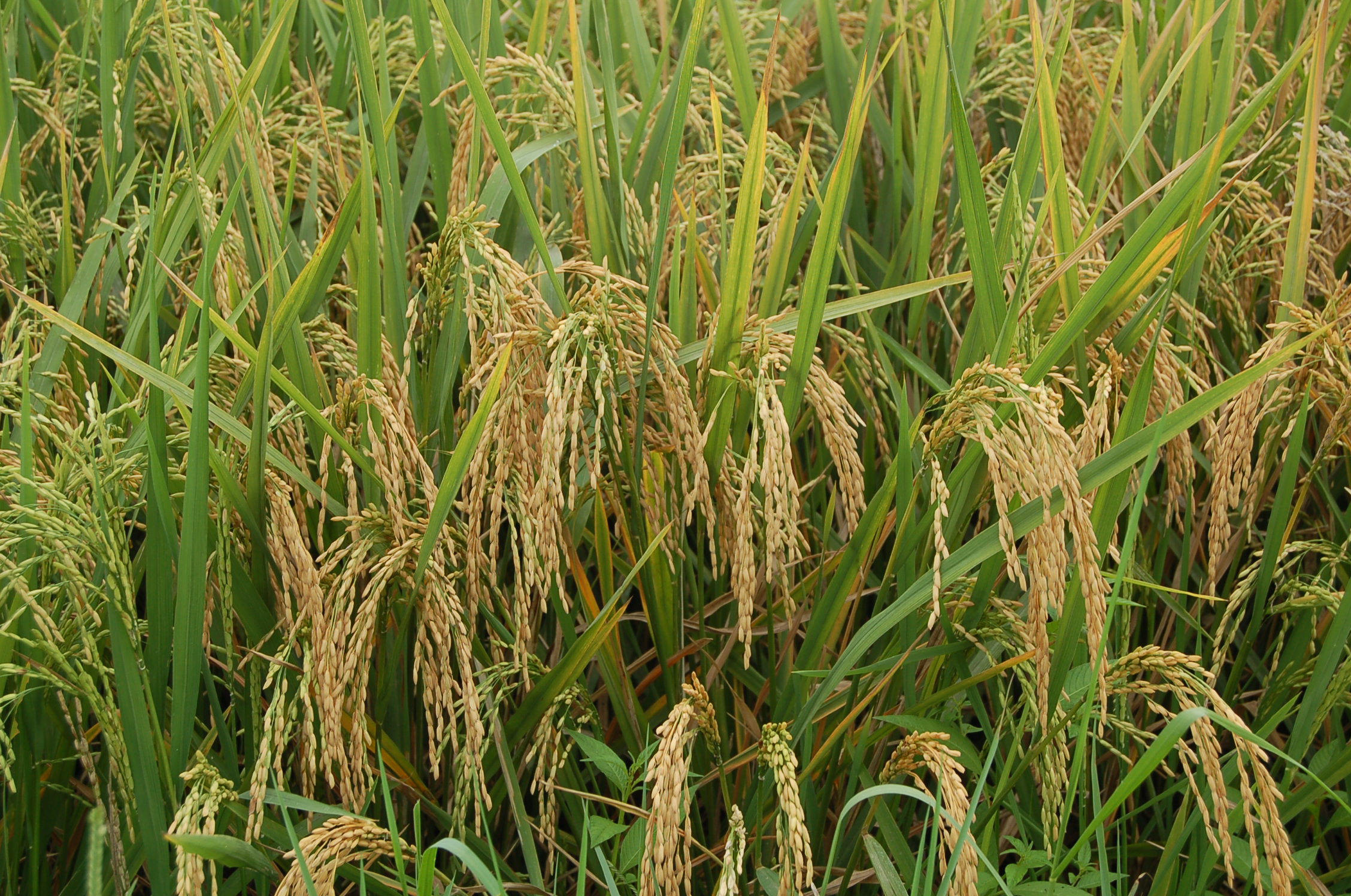Text and Photos by Henrylito D. Tacio
Additional Photo: IRRI
Filipino farmers can now help the Department of Health (DOH) in its fight against vitamin A deficiency (VAD). This can be accomplished by planting golden rice in their farms.
Golden rice, a genetically-engineered rice variety, was approved for commercial propagation last year. And Philippine Rice Research Institute (PhilRice), an attached agency of the Department of Agriculture, is now ramping up its seed production operations so that it can deploy the seeds to interested farmers soon.
In fact, last May 6, PhilRice handed over golden rice seeds to farmers who will participate in the expanded golden rice seed production in the coming wet season planting. The ceremonial handover was witnessed by Agriculture Secretary William Dar during his visit to the institute’s central experiment station in the Science City of Muñoz in Nueva Ecija.
“We are committed to ensuring the highest quality of seed for farmers and a safe and nutritious food supply for all Filipinos,” said Dr. John de Leon, PhilRice executive director.
Golden rice contains additional levels of beta-carotene, which the body converts into vitamin A. “Golden rice is engineered to provide up to 50% of the estimated average requirement for vitamin A of young children, the age group most susceptible to VAD in the Philippines,” said PhilRice in a statement.
In the Philippines, VAD continues to be “a significant public health issue” as it affects nearly 17%, or two million Filipino children under the age of 5, based on the 2018 Expanded National Nutrition Survey conducted by the Food and Nutrition Research Institute of the Department of Science and Technology (DOST).
VAD results from a dietary intake of vitamin A that is inadequate to satisfy the physiological needs. “It may by exacerbated by high rates of infection, especially diarrhea and measles,” the World Health Organization (WHO) explained in its website.
VAD is common in developing countries like the Philippines but rarely seen in developed countries like the United States and Great Britain. The most severe effects of this deficiency are seen in young children and pregnant women in low-income countries, the WHO said.
According to WHO, night blindness is one of the first signs of VAD. “In its more severe forms, VAD contributes to blindness by making the cornea very dry, thus damaging the retina and cornea,” the United Nations health agency pointed out.
Data from WHO showed an estimated 250,000 to 500,000 children who are vitamin-A deficient become blind every year. “Half of them die within 12 months of losing their sight,” the WHO added.
The WHO said deficiency in vitamin A is associated with significant morbidity and mortality from common childhood infections. It described VAD as “the world’s leading preventable cause of childhood blindness.”
In addition, VAD also contributes to maternal mortality and other poor outcomes of pregnancy and lactation. It also diminishes the ability to fight infections.
“Even mild, subclinical deficiency can be a problem, because it may increase children’s risk for respiratory and diarrheal infections, decrease growth rates, slow bone development and decrease the likelihood of survival from serious illness,” the WHO said.


Experts believe golden rice is one of the best ways to cut the prevalence of VAD.
“It is clear that multiple approaches are required in fighting VAD. An additional tool in the toolbox such as golden rice – one that can be seamlessly integrated into the everyday lifestyles of even the poorest sectors of society – can be a concrete, sustainable solution to ensure proper nutrition,” said the Laguna-based International Rice Research Institute (IRRI).
Although rice (known in the science world as Oryza sativa) is a complex carbohydrate, its protein contains all eight of the essential amino acids and complements the amino acids found in many other foods. It is low in sodium, fat, and fiber, it is easily digested.
Most of the rice available in the market is enriched, which means, besides its other assets, it is also supplemented with iron, niacin, and thiamine. But most of these added nutrients are lost if rice is washed before cooking or drained afterward.
By putting beta-carotene in rice, Filipinos can have the much-needed vitamin A. “The beta-carotene produced in golden rice grain is identical to the beta-carotene in green leafy and many types of yellow-colored vegetables and orange-colored fruit, and identical to synthetic beta-carotene found in many vitamin supplements and food ingredients,” the IRRI says.
“I always say there are interventions like diversifying diet, breastfeeding, fortification and so on,” admitted Dr. Violeta Villegas who said those words when she was still the IRRI golden rice project coordinator. “They’re working but the fact remains that there’s still a sizable portion of our population not reached by these interventions.
Studies reviewed and published in the American Journal of Clinical Nutrition found that golden rice is an effective source of vitamin A for adults and children.
“While golden rice is expected to cost and taste the same as regular rice, its beta-carotene content makes it a valuable asset in the battle against vitamin A deficiency (VAD),” IRRI said.
The beta-carotene in golden rice is identical to the beta-carotene found in green leafy (malunggay, for instance) and yellow-colored vegetables (carrot and squash), orange-colored fruits (mango and papaya), and even in many vitamin supplements and food ingredients.
But one good thing about golden rice is that no company owns it. Thus, farmers can plant them anytime and anywhere.
“Golden rice is being developed by a nonprofit group with the aim of providing a new source of vitamin A to people both in the Philippines, where most households get most of their calories from rice, and eventually in many other places in the world where rice is eaten every day by half the population,” wrote Amy Harmonaug in an article which appeared in The New York Times.
The men credited for discovering the golden rice were Ingo Potrykus, who was 65 at that time and was about to retire as a professor at the Swiss Federal Institute of Technology in Zurich, and Peter Beyer of the University of Freiburg. “My team targeted vitamin A deficiency because this is one of the largest health problems worldwide,” Prof. Potrykus was quoted as saying.
Golden rice has been bred with local rice cultivars in the Philippines and Taiwan and with the American rice cultivar “Cocodrie.”The first field trials of these golden rice cultivars were conducted by Louisiana State University Agricultural Center in 2004. According to scientists, field testing provides a more accurate measurement of nutritional value and enables feeding tests to be performed.
In the Philippines, the first-generation golden rice was first tested in advanced field trials in IRRI in 2008. The second generation of selected varieties was field tested in the wet season of 2010. At the state-owned PhilRice, confined field trials of advanced lines were conducted in February to June 2011.
“The field trials are an important step in evaluating the performance of golden rice and to determine if it can be planted, grown, and harvested just like other popular rice varieties,” PhilRice said in a statement. “These trials are also part of the safety assessment of golden rice.”
In 2019, golden rice passed a rigorous biosafety assessment in the country and was declared “as safe as conventional rice” by the Bureau of Plant Industry of the Department of Agriculture. “As soon as the necessary approvals are in place, golden rice can be made available to the public.”
In July last year, golden rice was approved for commercial propagation. It has already received food safety approval in Australia, New Zealand, Canada, and the United States. It is currently undergoing final regulatory review in Bangladesh.
Research and development of golden rice adhere to scientific principles developed over the last 20 years by international organizations like the WHO, the Food and Agriculture Organization (FAO), the Organization for Economic Co-operation and Development (OECD), and the Codex Alimentarius Commission.
Although golden rice has met significant opposition from environmental and anti-globalization activists, more than 100 Nobel laureates in 2016 encouraged use of genetically modified golden rice.
Both IRRI and PhilRice never claim that golden rice “will totally solve VAD.” In most of their issued statements, both have always emphasized that golden will serve as a complement – not a replacement – to current strategies to ease VAD, referring to supplementation, fortification, and eating diverse diets.
“When and where these (strategies) are not available, golden rice is an option, with the decision to plant or consume golden rice still left to each individual,” said a press statement.
Meanwhile, farmers have not to worry about planting golden rice which may have harmful effects on other rice varieties. “Golden rice is not likely to impact organic agriculture through cross pollination,” PhilRice assures.
According to PhilRice, cross-pollination in rice is rare if plants are separated by a short distance of a few meters. “Cross-pollination in rice is uncommon, unless all the rice plants are flowering at the same time,” it explains. “Rice pollen is normally viable for only a few minutes after flowering.”
In other words, organically-grown rice will not cross-pollinate naturally with other cultivated rice, “unless they are growing close together and flowering at the same time.”

